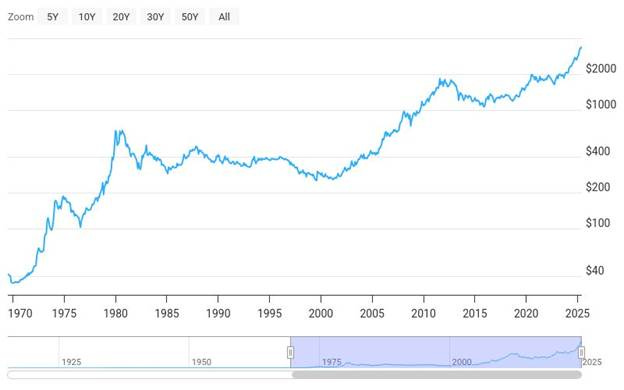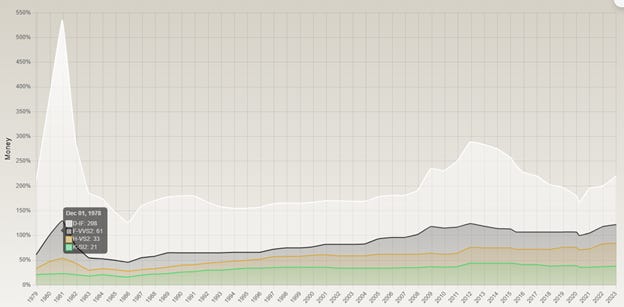Texas Wants Bitcoin. History Wants a Word
What gold, diamonds, and past manias can teach us about today’s crypto moves
Last month, the Texas House passed legislation to establish a strategic Bitcoin Reserve. Once enacted, Texas will become the third state to incorporate Bitcoin into its financial strategy.
Proponents of the bill argue that this is a necessary step to combat inflation and claim that we are still in the early stages of the crypto boom.
However, I’m here to remind you that we’ve seen these trades before, and historically, they’ve not gone well.
Big, slow-moving institutions tend to enter trades closer to the top than the bottom.
For example, by December of 1979, gold had reached a price of $524 per ounce after climbing from $35 in 1970. The stock market had fallen out of favor, inspiring BusinessWeek to famously publish "The Death of Equities," an article arguing that the stock market would never recover and that hard assets, such as gold and diamonds, were the superior stores of value.
Reporting back in 1979, the author wrote:
Today, one of the strongest proponents of gold investing is Alaska Governor Jay Hammond. He plans to resubmit a bill to the legislature early next year to lift a law, passed in the early 1960s, that prevents the state’s public employee and teachers retirement funds from investing in gold.
“The statute was fine for the 1960s, but unfortunately we’re not living under those same economic conditions,” says Alaska’s deputy treasury commissioner, Peter Bushre. “We’re living under double-digit inflation, huge balance-of-trade deficits, and a serious energy problem. The current action of both the bond market and equity market bear me out.”
At least 20 banks now include hard assets in their pension accounts. First State Bank of Oregon, which has allowed customers to put gold and silver into retirement accounts since 1974, is now letting them add diamonds. “We’re going to see more and more investment in diamonds, gold bars, Krugerrands, and silver coins,” predicts Vice-President Richard W. Rhodes.
Fast forward a few months after the article was published, and both gold and diamonds fell off a cliff. By 1985, the yellow metal had declined by more than 50% from its highs and remained similarly depressed until around 2001. Gold did not return to its 1979 price until around 2007 – a notable 28 years later.
The prices for diamonds still haven’t recovered and likely never will.
But what about the new stablecoin legislation that just passed? Isn’t that going to huge for crypto investors?
Probably not.
As the same BusinessWeek article from 1979 begins:
On July 23 institutions that manage pension fund money began operating under a new and far more liberal interpretation from the Labor Dept. of what is a prudent investment under the Employee Retirement Income Security Act of 1974 (ERISA). Pension fund money can now go not only into listed stocks and high-grade bonds but also into shares of small companies, real estate, commodity futures, and even into gold and diamonds. “The decision throws the door wide open to hard assets for institutional investors,” says a jubilant Jack B. Backer, a New York diamond dealer.
As noted above, the quoted diamond dealer’s jubilance was short-lived.
Because it always is.
Every time an asset class experiences a multi-year period of outperformance, the people who have benefited the most are jubilant and expect current trends to persist. But they never do.
As another example, in 2011, after gold had risen by more than 700% over the previous decade, the University of Texas decided it needed to invest $1 billion in bullion.
The price dropped shortly thereafter and didn’t return to those levels for another 10 years.
Keep this in mind when someone cites legislation or institutional uptick as a cause for optimism about an asset that has already been on an incredible, multi-year run.
Crypto may be new and exciting, but humans and history tend to have a way of repeating themselves.
Personal note:
We made it out to Park City a day early for this weekend’s lacrosse tournament.
Back to the 100 degree heat index of Houston on Monday.







SUPER ! BEAUTIFUL !
1972-74 I lived in Salt Lake City , working with CONOCO ( in Woods Cross ). 1st time to snow ski - it immediately became my life-long passion! Helicopter Skiing in Canada for 25 years !
‘74 -‘75 CONOCO assignment - Spokane WA ; ‘75-‘76 CONOCO assignment - Newport Beach CA ; ⛷️ was “ EXPERT “ when I left Newport Beach CA !
When it comes to writing about investments, the disclaimers are important. Past performance is not indicative of future returns, my opinions are not necessarily those of TSA Wealth Management, an SEC-registered investment advisor, and this is not intended to be personalized legal, accounting, or tax advice etc.
For additional disclaimers associated with TSA Wealth Management please visit https://tsawm.com/disclosure or find TSA Wealth Management's Form CRS at https://adviserinfo.sec.gov/firm/summary/323123